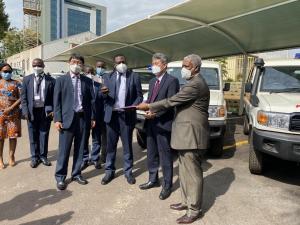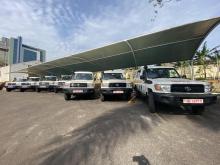The Government of Korea partners with WHO to support Maternal Health and Child Health Delivery in Busoga Sub-region, Eastern Uganda
Busoga sub-region in eastern Uganda typifies the social and economic challenges that poor countries are constantly grappling with. Situated in the eastern part of the country and comprising 11 districts with a population of 3,918,500 people, the sub-region is ranked third poorest in the country by the Uganda Bureau of statistics.
Recent poor agricultural harvests, which is the main economic activity in the sub-region, occasioned by poor climatic conditions and an invasion by armyworm worsened food insecurity negatively impacting the nutrition, health, and growth especially among children and pregnant women.
Consequently, poverty has led to glaring disparities in access to social services such as health and education. Sadly, the disparities are also discernable between districts, communities, families, and even between men and women leading to very poor health outcomes.
Although Uganda has registered tremendous progress in the health sector, maternal and child health continues to pose formidable challenges for the entire country. But in Busoga sub-region, the situation is even worse compared to national averages.
For instance, national neonatal mortality stands at 27 deaths per 1,000 live births but in the Busoga region, it is 28 deaths per 1000 live births. The average national infant mortality is 43 deaths per 1000 live births birth, while in the Busoga region it is 53 deaths out of 1000 live births. Regarding maternal health, figures indicate that while 336 mothers out of 100,000 live births die annually due to childbirth complications, for Busoga sub-region, the figure is 448 mothers.
The manifestation of this has been the high maternal and child mortality and morbidity rates that have been registered in the sub-region which, fortunately, have been noted by government officials and development partners with a keen eye on the country’s social-economic development.
One such partner is the Korea International Cooperation Agency (KOICA), a government of the Republic of Korea institution responsible for coordinating Official Development Assistance (ODA) in developing countries such as Uganda. In partnership with the government of Uganda and the World Health Organization (WHO), KOICA is supporting the implementation of a 10 million US dollars project intended to increase delivery of reproductive, maternal, neonatal, child, and adolescent health services as well as improve health systems in five poorly performing districts of Busoga sub-region. Dubbed “Health System Strengthening for Improving RMNCAH Service Delivery in 5 districts in Busoga sub-region, Uganda”, the project will be implemented in Bugiri, Buyende, Iganga, Kamuli and Mayuge Districts. In addition to one million USD to supplement the project, WHO is charged with technical support in the implementation of the project, support supervisor, procurement of supplies and logistics, and training of health and district staff.
It is anticipated that by December 2024, this project will have benefited 560,809 pregnant women, 499,852 newborn babies, 349,327 in school adolescent boys and girls aged 10 – 19 years, and 687 teachers from both primary and secondary schools in those districts. In addition, 159 health workers and 1,480,200 people especially out of school adolescents aged 10 to 19 years, parents, religious and cultural leaders) in Busoga region will also benefit from the project.
To kick-start the implementation, WHO procured and presented seven state-of-the-art ambulances with funding from KOICA. These ambulances were presented to the Ministry of Health and to the beneficiary districts at a colorful ceremony held at the Ministry headquarters on the 19th of May 2021.
“The Government of the Republic of Korea is committed to supporting the strengthening of the health system in Uganda. We hope that the ambulances handed over to Busoga sub-region today will contribute towards improving the accessibility and utilization of maternal and child health services as well as realizing the vision of the Emergency Medical Services strategic plan,” said His Excellency Ha Byung-Kyoo, the Ambassador of the Republic of Korea in Uganda, while handing over the ambulances.
Indeed, such assistance comes in handy for a sub-region that is characterized by the poor performance of the health care system due to inadequate numbers of staff, poor skills mix of the staff, and poor infrastructure. It will go a long way in addressing challenges such as the estimated 25% of mothers who die in Busoga sub-region from bleeding complications occasioned by inadequate health worker skills and shortages in commodities to manage bleeding.
Fully aware of health challenges faced by communities in this sub-region, Dr. Yonas Tegegn Woldemariam, the WHO Representative in Uganda appreciated the timely support from KOICA noting that, “bringing together the representatives of frontline health workers that are facing the challenges of ensuring access for their clients in terms of poor transportation, actual space, infrastructure, numbers of health workers, availability of relevant medicines, governance and leadership issues as well as professional ethical challenges is indeed a worthy cause”. He hoped that through this program, “we shall be able to support Bugiri, Buyende, Iganga, Kamuli, and Mayuge to build systems that will improve the quality of care resulting into better health outcomes of the targeted communities.”
The partnership intervention by the Ministry of Health, KOICA and WHO in Busoga sub-region should enable women and children in the five districts to enjoy the benefits of Universal Health Coverage in addition to presenting scalable best practices. But as the Director of Clinical Services, Dr. Charles Olaro rightly noted at the ambulance handover ceremony, “it is a process that requires identifying persistent problems and offering the right interventions” – just as KOICA and WHO have done in Busoga.
Dr. Olaro also thanked the Government of South Korea for providing the funding that has made this project possible and WHO for providing administrative and technical support. “It is my sincere hope that by the end of the project implementation sustainable improvements in the health indicators of the targeted population in the Busoga region will be realized,” he concluded.
Health Promotion Advisor
Tel. : +256 414 335505
Cell: +256 772 507906
Email: sensasib [at] who.int (sensasib[at]who[dot]int)
Public Information Officer
Tel. : +256 313 335569
Cell: +256 786 497073
Email: mwebembezie [at] who.int (mwebembezie[at]who[dot]int)




